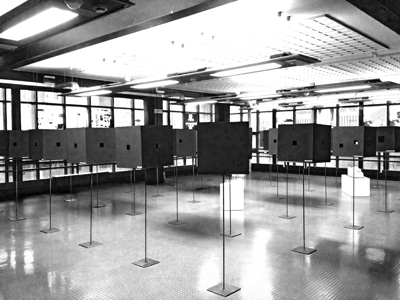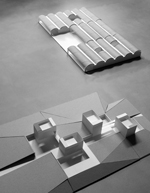You are in: Home page > Magazine Archive > Fragments of an Educational Speech

Exhibition «Scoprire l’architettura» by first year course «Elementi di Architettura», a.a. 2012-2013, Scuola di Architettura, Politecnico di Milano
Abstract
Opening the work, opening course: the proposed criterion is conducted on fragments of a many voices speech describing it, opening it to different interpretations and possibly precise it by the relations between writer and reader. The path follows the traces of examples that may define general principles, opening tools towards other contests.
There are problems that don’t allow a general solution but single solution that, put together walk up to the general solution.
Robert Musil, The Man Without Qualities
The work of teaching has as its primary objective the development of the ability to process knowledge gradually acquired. This contribution covers a method of education for the architecture, using as structure of the text, the same structure that we intend to develop. With the intention to offer, just like the practice of teaching I’m looking for, a composition of samples for the reader, his personal interpretation; it is a structure of the text (and method) that I would define open.
1. Opening of the work, opening teaching. The proposed test is carried out on fragments of a many voices speech describing it, opening it to different interpretations and precise it thanks to the changing relationship between the teller and the listener. The route follows the traces left by selected examples that can define general principles, that is tools to enable more openings to other contexts. “Hence the function of open art as a epistemological metaphor: in a world in which the discontinuity of the phenomena has put in crisis the possibility of a unified and definitive image, it suggests a way of looking what you live, and seeing accept it, integrate it to your sensibilities. An open work addresses fully the task of giving us a picture of the discontinuity: it doesn’t tell it, it is it. Mediating the abstract category of scientific methodology and the living matter of our sensibility, it seems almost a kind of transcendental scheme that allows us to understand new aspects of the world “(Eco). The same track presented here could be a fragment of a deep sense of education to architecture.
2. Erich Auerbach, in “Mimesis,” says: “My effort to precision is directed to the individual and to the concrete, while the general formulas necessary to compare, group or define the phenomena to each other had to be fluid and elastic. They had to adapt case by case to the possibilities generated from the single object, and must be interpreted case by case on the basis of the context. [...] I wanted, if it’s possible, do not use any general expression, but suggest thoughts to the reader through the mere presentation of a succession of individual facts “(Auerbach). The Mimesis fixed the intention of working by paradigms, that is “individual facts” that may react with the imaginative capacity and the reader research objective to open an independent thought towards general principles.
This reflection rooted in my own experience of practice and teaching of the project, involving it and from there extending through methodological nodes that substantiate it, here exemplified in the various forms of the fragments. They combine the experience of personal research, the level of reality that is investigated and lives, the discipline area in which you place the process, with its references and its tradition.
3. “The more I ponder my art, the more I practice it: the more I think and act, the more I suffer and I enjoy to be an architect, and I identify strongly with delight what I am. Lost in long attend, I find myself for the surprises that caused me and, through these successive degrees of my silence, I proceed in building myself, I approach so faithful correspondence between aspirations and my ability to believe that I transform my life in a kind of human building. So much I build, to believe I built myself”(Valéry).
The theme of education to the architectural project is therefore considered in holistic terms involving the construction of self and the realization of our practice: self as being and self as act. This assumption of the involvement of the same figure of the teacher in the project process of teaching, leads the experience of the construction to a close sharing, continually self-critical. It is, in fact, a holistic process that rests on the relationship between people, information, specific needs. Putting also yourself as research field means getting in the path of teaching of architectural design (and perhaps also in other disciplines complex), an effective communication between teachers and students that shares and makes available examples such as concrete instruments to be experienced, rather than sterile hortatory statements.
4. «We have to recognize that the effects of that research (architectural, in the 60s and 70s) did not in any way lead to the construction of a unified theoretical basis, but to the formation of a series of theoretical fragments scattered and contradictory, though for this no less important. Above all these new theories have not produced adequate procedures for the passage from principles to architectural practice. [...] The principles have not become rules and transmitted methods, but they were models and then the imitation rapidly became the only formal educational system practiced» (Gregotti).
Gregotti, which loves Mimesis reference by having dedicated an editorial in Casabella, is conducted here as a reference to a school where I feel I belong. The first value that I attribute to that school of thought lies precisely in this: the uninterrupted construction and practice of independent thought and critical (and self-critical) as the basis of its relationship with reality.
5. For Gregotti this assumption is what substantiates in depth, and thus constantly regenerates, the same idea of modernity. The interpretative glaze as an educational tool is the premise of this tradition; his teacher, Ernesto Rogers, speaks of “Orthodoxy of heterodoxy” by Baudelaire: «As for the criticism itself, I hope that philosophers will understand what I say: to be right, that is to have its raison d’être the critic should be partial, passionate, political; that is made by an exclusive point of view, but which also opens more horizons» (Baudelaire).
Study and project are ways of exercising our criticism about reality. The architectural project, and therefore the study of architecture, is a profound way to know the space, the atmosphere, the location, the territory, the city, the landscape: the reality. To change it. The critical view is not objective, but wants to understand reality. It means the difference between reality (singular) and truth (always plural), questioning even itself. It understands the need of relationship to make further steps toward comprehension. It assumes the responsibility of being relative and partial, passionate and political, in order to activate, with the report, wider horizons.
6. In the «Craft of the architect» Rogers returns to the role of the autonomy of thought reporting the words of one of his references, Walter Gropius: «My intention is not to transplant, so to speak, cut and devoid of its sap one «Modern Style» [...] but rather to suggest a method of approach that allows the individual to deal with a problem according to his peculiar inclination. [...] It is not a ready-made dogma that I want to teach, but rather an independent and flexible attitude towards the problems of our generation» (Rogers). The teacher is in such a relationship with the student: he does not impose an idea of the world, it does not determine what to play; conversely is more inclined to discuss a mode of reasoning; a construction that involves both ideas.
7. Carlos Martí Arìs recognizes in its master, Giorgio Grassi, one of these figures: a reagent which reveals the moment of crisis and forces the activation of personal thought. They are figures that do not replace with a reassuring solution finding for us the target. «Some fully deserve the title of «difficult master», because in them we find no protection or consolation but, rather, a moral question and deep consciousness of the fact that ours is a way to go alone, and with no guarantee that it finally will bring us to some place». (Aris).
8. The crucial point is obviously the communication one. The ability to communicate coincides with listening. Education is education in listening and relates more who have to communicate. Listen: in which architecture can track the listening skills that should have substantiated it? How much is it available to be the frame or the background of local phenomena? «I felt the ruthlessness of that life: things ran side by side, without ever really tackled. It was clear not only that no one understood the other, but no one wanted to understand it. [...] When they spoke, it was as if they were looking each other in a distorting mirror, they are presented in fact in misrepresentation of the words, become, presumably, their portrait. When trying to make themselves understood, they failed miserably and blamed each other so clumsy that the offenses were playing praise and praise offenses. Their impotence moved me. [...] The innate helplessness and concealed individual who belonged to themselves, that they had nothing in common with each other, let alone the word, that rather than unite them, separated them»(Canetti).
9. The opening of the work, of teaching, of learning, takes place then with the reflexive project, with the criticism, by listening: that is, with the activation of a complex milieu and, according to the conditions, holistic. «A way of thinking that can interconnect knowledges is able to extend towards an ethics of interconnection and solidarity between humans. A thought that can not shut himself in localism and in the particular, but capable of understanding sets, it would be suitable to foster the sense of responsibility and citizenship. Thought reform would have therefore existential, ethical and civic consequences» (Morin).
So Morin defines the role of complex thought; the plot of the current quantity and quality in the game can only lead to a field of research. The fragments that populate it can trigger, if made available, a possibility of integration between people, things and ideas; provided that our responsibility is translated operationally in opening up our fences, in self-education to listening, in the generosity of understanding teaching as a handover to those who practice the future as their time. The key to open the project of present time.
Reference
Arìs C. M. (2007). Maestri difficili, a proposito di Giorgio Grassi, in: La centina e l’arco. Milano: Marinotti.
Auerbach E. (1946). Mimesis. Il realismo nella letteratura occidentale. Torino: Einaudi.
Barthes R. (1979). Frammenti di un discorso amoroso. Torino: Einaudi.
Canetti E. (1982). Il frutto del Fuoco, Storia di una Vita (1921-1931). Milano: Adelphi.
Eco U. (1962). Opera Aperta, Forma e indeterminazione nelle poetiche contemporanee, Milano: Bompiani.
Gregotti V. (1983). Mimesis, Casabella (n. 490), 2-3.
Morin E. (2000). La testa ben fatta, Riforma dell’insegnamento e riforma del pensiero, Milano: Raffaello Cortina .
Musil R. (1957). L’uomo senza qualità, Torino: Einaudi.
Rogers E. N. (1958). Esperienza dell’architettura, Milano: Einaudi.
Rogers E. N. (1957). Ortodossia dell’eterodossia, in Casabella Continuità (n. 216), 2-4.
Valéry P. (1997). Eupalino o l’architetto, Pordenone: Biblioteca dell’Immagine.
Andrea Di Franco (1966) is an architect and Associate Professor in the Department of Architecture and Urban Studies of the Politecnico di Milano. He graduated in 1992, in 2006 he obtained a PhD in Architecture and Urban Design. In 2008 he was employed as assistant professor indefinitely in Architectural Design Department of Architecture and Urban Studies. He is a member of the Academic Board of the PhD in Architectural Design, Urban and Interior. He is a member of the Scientific Committee of the series "Polytechnic", Maggioli Publisher and the series "Borders, foundations and tools of architecture", Christian Marinotti Publisher. He is a member of the editorial staff of the scientific magazine of the Department, "Territorio".















